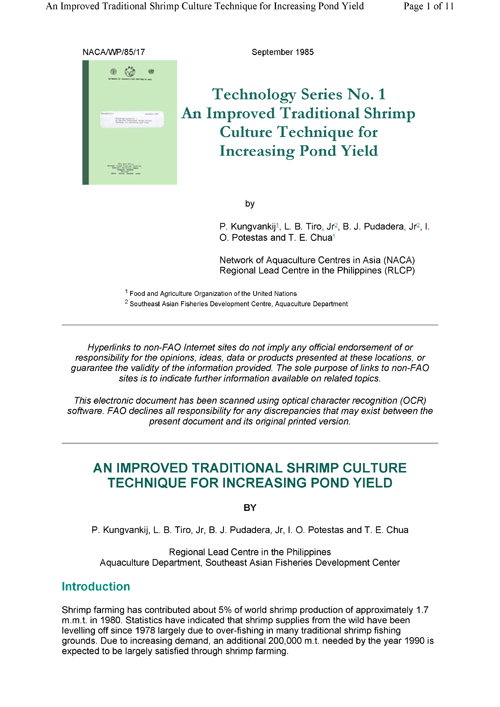An improved traditional shrimp culture technique for increasing pond yield
15 November 2004 | P. Kungvankij, L.B. Tiro Jr., B.J. Pudadera Jr., I.O. Potestas and T.E. Chua | 1738 Downloads | .pdf | 889.82 KB | Nutrition and feeding, Philippines, Shrimp, Water quality
Shrimp farming has contributed about 5% of world shrimp production of approximately 1.7 m.m.t. in 1980. Statistics have indicated that shrimp supplies from the wild have been levelling off since 1978 largely due to over-fishing in many traditional shrimp fishing grounds. Due to increasing demand, an additional 200,000 m.t. needed by the year 1990 is expected to be largely satisfied through shrimp farming.
In 1980, more than 84% of world shrimp production through aquafarming were derived from seven Asian countries of which Southeast Asia contributed approximately 45%. Most of the shrimp farms in the developing nations (80% in Southeast Asia) are still operating on the traditional or extensive method of farming. Such traditional farms are characterised by low stocking densities (e.g. 5,000/ha) and hence low yield ranging between 100 to 300 kg/ha/yr, irregular pond size and shape, relatively low technical management inputs as well as comparatively small investment. Because of high market price, such traditional practices are still commercially viable to small-scale shrimp growers despite low pond yields.
Shrimp yields in ponds can be_increased by application of modern farming techniques such as intensification of culture operation by regularisation of pond size, increasing stocking rate, employment of aeration application of formulated feed, etc. This will mean a considerable increase of financial and technological inputs, which most small farmers in the developing countries may be able to afford.
In order to provide shrimp growers with an appropriate technology that will immediately improve their pond yields and hence increase their income, a series of research studies has been conducted by SEAFDEC-NACA to refine existing traditional culture practices for the tiger shrimp, Penaeus monodon. Results showed that the natural food produced in a shrimp pond through fertilisation is not fully consumed in the first two months at a stocking rate of 5,000 postlarvae per hectare. Research studies have demonstrated that the natural food produced by organic and inorganic fertilisation using the traditional practice can sustain an optimal growth of shrimp at a density of 20,000 postlarvae per hectare for a period of 60 days.
Supplementary feeding is needed to sustain the growth of the shrimps after 60 days by feeding with formulated pellet feeds or trash fish. Research has further proven that excessive stocking over 20,000 post larvae per hectare in such traditional shrimp farm affects growth resulting in reduced rate of returns to investments.
The present research was conducted in earthen ponds utilising tidal energy for water replenishment and maintenance of water quality. Research findings indicated that growth is accelerated after each molting, which usually occurs during spring tides, when the pond water is renewed. Hence, intensive feeding during this period enhances shrimp growth.
These research findings have been packaged and tested at government extension farms as well as in private shrimp farms in the Philippines. The results have indicated yields ranging from 350-500 kg per crop (120-150 days) or 700 to 1,000 kg/ha/yr. This packaged technology is by no means complete or perfect but serves to provide interested traditional shrimp growers with the necessary appropriate techniques to increase at least two to five-fold their existing production with minimal additional inputs.
Creative Commons Attribution.

